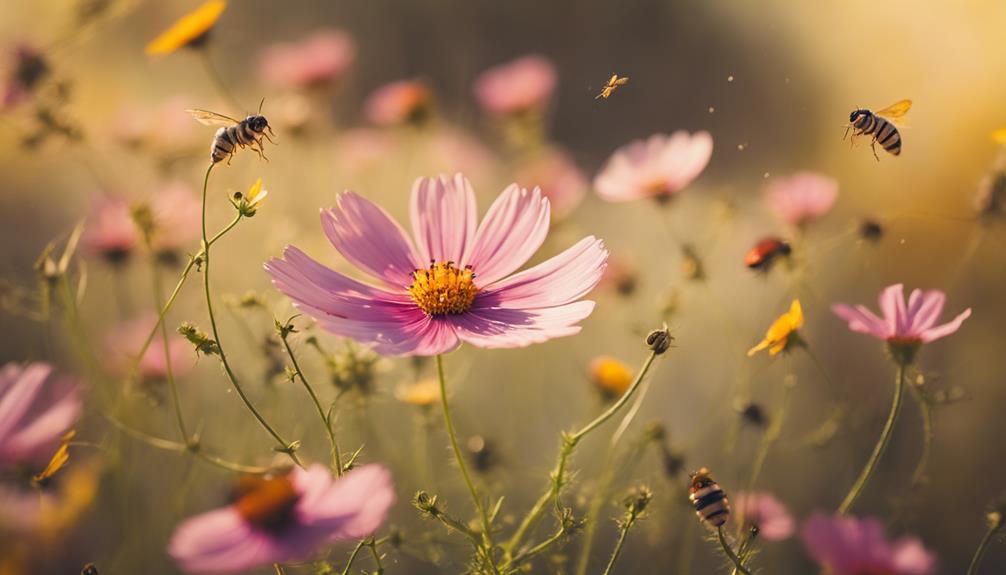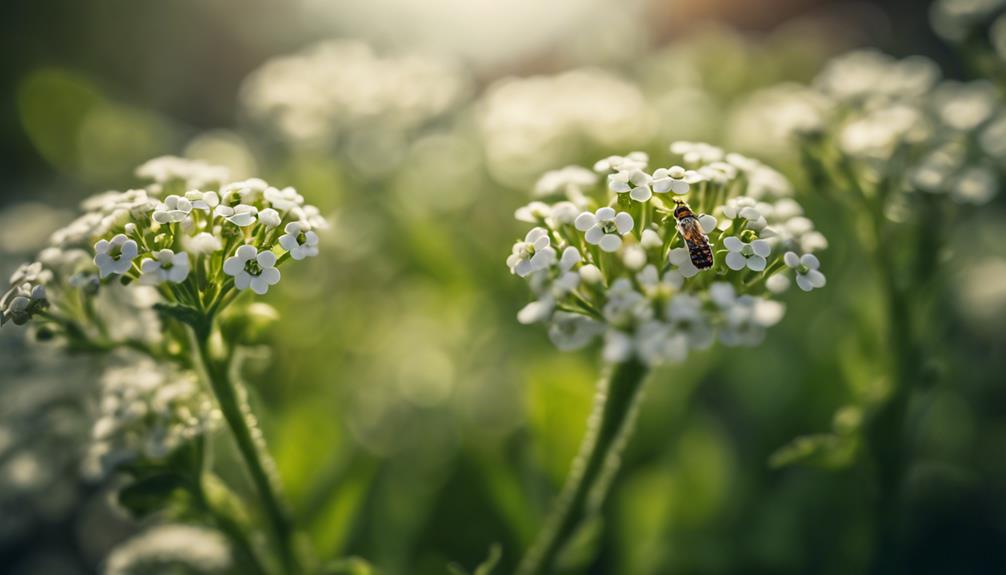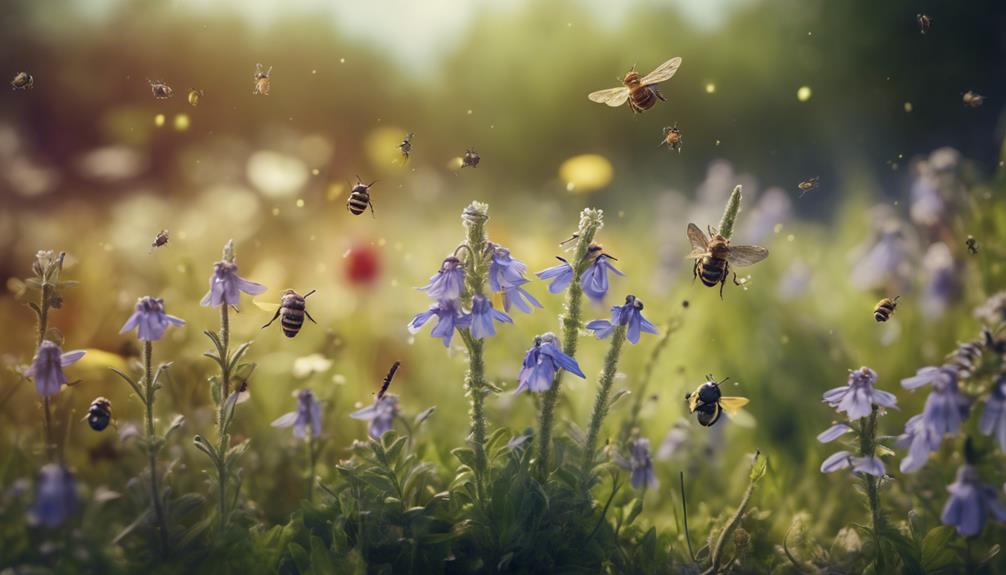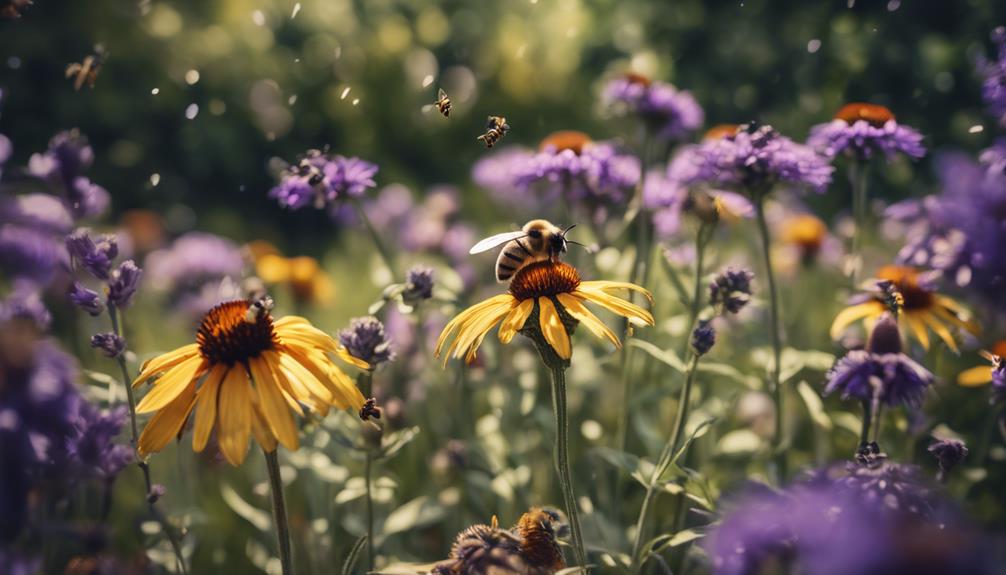You can attract beneficial insects, such as ladybugs, lacewings, parasitic wasps, and hoverflies, by incorporating seven specific plants into your garden. Yarrow, dill, cosmos, fennel, alyssum, mallow, and lobelia provide a rich source of pollen and nectar for adult beneficial insects to feed on, while offering a safe haven for insect eggs and larvae to develop. These plants also deter unwanted pests, creating a welcoming environment that attracts beneficial insects and keeps pests at bay. By understanding the unique characteristics of each plant, you'll be one step closer to creating a balanced ecosystem that works in your favor.
Table of Contents
Key Takeaways
- Planting yarrow, dill, cosmos, fennel, alyssum, mallow, and lobelia attracts beneficial insects that naturally control pests.
- These plants provide a rich source of pollen and nectar for adult beneficial insects to feed on and thrive.
- They offer a safe haven for insect eggs and larvae to develop, ensuring a robust beneficial insect population.
- Beneficial insects attracted to these plants include ladybugs, lacewings, parasitic wasps, and hoverflies, which prey on pests like aphids and mosquitoes.
- By attracting beneficial insects, these plants create a welcoming environment that deters unwanted pests and maintains a healthy garden ecosystem.
Yarrow: A Triple Threat Attractor
When incorporating yarrow into your garden, you'll find that this perennial plant is a triple threat attractor, offering a trifecta of benefits that make it an ideal addition for drawing in beneficial insects.
By planting yarrow, you'll attract a variety of beneficial insects, including ladybugs, lacewings, parasitic wasps, and hoverflies, which will help to naturally control pests in your garden.
The common yarrow variety is particularly appealing to these insects, providing a rich source of pollen and nectar for them to feed on.
Yarrow's flowers offer a sweet treat for adult beneficial insects, while its leaves provide a safe haven for insect eggs and larvae to develop.
Plus, yarrow is a natural pest repellent, deterring unwanted pests like mosquitoes, aphids, and spider mites.
By growing yarrow, you'll create a welcoming environment that will attract beneficial insects and keep pests at bay.
With its ease of growth in full sun and well-drained soil, yarrow is an excellent choice for any garden looking to attract beneficial insects.
Dill: A Haven for Helpful Insects
By adding dill to your garden, you'll create a haven that attracts a diverse range of beneficial insects, including ladybugs, lacewings, and parasitic wasps, which will help to naturally control pests and create a balanced ecosystem.
As a member of the carrot family, dill's umbelliferous flowers are a magnet for these helpful insects. By planting dill, you'll not only attract beneficial insects but also enhance the overall health of your garden.
Dill is a top pick for attracting beneficial insects for several reasons:
Ladybug Magnet: Dill's flowers are a favorite of ladybugs, which are notorious aphid-killers.
Lacewing Lure: The delicate, lacy wings of these beneficial insects are drawn to dill's umbrella-like blooms.
Parasitic Wasp Paradise: Dill's strong scent attracts parasitic wasps, which prey on garden pests like caterpillars and flies.
Pollinator Powerhouse: Dill's flowers also attract pollinators like bees and butterflies, adding to the garden's biodiversity.
Cosmos: Attracting Beneficial Visitors

Your garden will become a hotspot for beneficial insects with cosmos, an easy-to-grow annual flower that's highly attractive to hoverflies, parasitic wasps, and lacewings.
These beneficial visitors are drawn to cosmos' nectar-rich flowers, which provide the energy they need to thrive and multiply.
To grow cosmos, simply plant seeds directly in your garden after the danger of frost has passed, preferring full sun and well-drained soil.
With minimal maintenance, cosmos will bloom in a variety of colors, including pink, white, and red, adding a pop of color to your garden.
Fennel: Ladybird Magnet Plant
As you explore the benefits of fennel in your garden, you'll discover its unique attraction power, which makes it a ladybird magnet plant.
You'll learn how fennel's aniseed-flavored leaves and stems provide a favorite food source for ladybirds, giving them the energy they need to thrive and reproduce.
Fennel's Unique Attraction Power
Fennel's unique attraction power stems from its sweet, aniseed-like flavor and aroma, which acts as a potent magnet that draws ladybirds into your garden.
By growing fennel, you're creating a ladybird-friendly habitat that encourages these beneficial insects to visit and stay, providing natural pest control and promoting a healthy ecosystem.
Ladybird magnet: Fennel's sweet flavor and aroma lure ladybirds away from other plants, making it an ideal addition to gardens struggling with aphid infestations.
Ideal growing conditions: Ladybirds are more likely to visit fennel plants grown in full sun and well-drained soil, promoting healthy plant growth and maximizing the plant's attractiveness to ladybirds.
Natural pest control: Ladybirds feed on aphids, black fly, and red spider mites, making fennel a valuable asset in your garden's defense against pests.
Ecosystem balance: By attracting ladybirds, fennel helps maintain a balanced ecosystem, ensuring a healthy and thriving garden that benefits from the presence of these beneficial insects.
Ladybird's Favorite Food Source
Growing fennel in your garden provides ladybirds with a nutrient-rich food source, as the plant's aniseed-flavored leaves and seeds support their growth and development.
Ladybirds are drawn to fennel's sweet, anise-like fragrance, which is emitted by the plant's flowers and leaves, drawing them in for a nutritious meal.
The tall, feathery foliage of fennel also provides ladybirds with a safe haven to lay their eggs and shelter from harsh weather conditions, making it an ideal plant for ladybird conservation.
Easy to Grow Companion
You can easily cultivate fennel as a companion plant, providing a haven for ladybirds and a natural pest control method in your garden. As a natural magnet for ladybirds, fennel's aniseed-like flavor and fragrance repel aphids and other pests, making it a great addition to your garden. Ladybirds are drawn to fennel's tall, feathery foliage and small yellow flowers, which provide a rich source of pollen and nectar.
Fennel attracts ladybirds, which feed on aphids, black fly, and red spider mites, helping to control pest populations naturally.
Fennel's aniseed-like flavor and fragrance repel aphids and other pests, reducing the need for chemical pesticides.
Fennel is easy to grow from seed and can be planted alongside vegetables, fruits, and flowers to create a balanced and diverse garden ecosystem.
Fennel's tall, feathery foliage and small yellow flowers provide a safe haven for ladybirds, encouraging them to stay and thrive in your garden.
Alyssum: Small but Mighty Attractor

With its delicate white blooms and tiny, honey-scented flowers, alyssum is an unassuming yet potent attractor of beneficial insects, drawing in a diverse range of species with its rich source of nectar and pollen. As you consider adding alyssum to your garden, you'll want to know that it's a low-growing flowering plant that's highly attractive to beneficial insects like hoverflies, lacewings, and parasitic wasps. These tiny flowers are a good source of nectar for adult beneficial insects, providing them with the energy they need to thrive.
| Beneficial Insect | Alyssum Benefit | Why It Matters |
|---|---|---|
| Hoverflies | Rich source of nectar | Supports hoverfly larvae, which prey on aphids and other pests |
| Lacewings | Abundant pollen supply | Enhances lacewing populations, which help control whiteflies and scale |
| Parasitic Wasps | Constant food source | Encourages parasitic wasp activity, which targets pest species like caterpillars |
Mallow: Parasitic Wasp Paradise
As you consider adding mallow to your garden, you'll want to focus on its wasp-friendly flower features, which are specifically designed to attract parasitic wasps.
These beneficial insects are drawn to the plant's delicate, five-petaled flowers that come in a range of colors, including pink, white, and yellow.
Wasp-Friendly Flower Features
What makes mallow an ideal haven for parasitic wasps is its unique combination of features, which provide a safe and nourishing environment for these beneficial insects to thrive.
As you consider adding mallow to your garden, you'll want to know what makes it so attractive to these helpful wasps.
Mallow's flowers provide a rich source of nectar for adult parasitic wasps, fueling their pest-controlling activities.
The flowers offer a safe place to land and feed, allowing the wasps to refuel and continue their work.
Mallow's flowers are rich in both pollen and nectar, making them an ideal spot for wasps to gather food.
The open, showy flowers of mallow make it easy for parasitic wasps to access the nectar and pollen they need.
Attracting Parasitic Wasps
By incorporating mallow into your garden, you create a haven that specifically attracts parasitic wasps, which are natural predators of aphids and other pests, and encourages them to stay and provide ongoing pest control benefits.
Mallow plants, particularly the common mallow and the musk mallow, are known to attract parasitic wasps, which lay their eggs on aphids and other pests, controlling their populations naturally. The nectar-rich flowers of mallow provide energy for the adult stages of parasitic wasps, allowing them to survive and reproduce.
| Mallow Feature | Parasitic Wasp Benefit | Gardening Advantage |
|---|---|---|
| Nectar-rich flowers | Energy source for adults | Attracts parasitic wasps |
| Low-maintenance growth | Easy to care for | Reduces gardening effort |
| Showy, pink or white flowers | Attracts parasitic wasps | Adds beauty to the garden |
Lobelia: Hidden Gem for Insects

You can attract parasitic wasps and other beneficial insects to your garden by incorporating Lobelia, a low-maintenance annual flower that offers a rich source of nectar and shelter from pests.
As a gardener, you'll appreciate the delicate blue flowers that bloom in the summer, providing a sweet treat for adult parasitic wasps. This, in turn, supports their energy needs and encourages them to stick around.
Natural pest control: Parasitic wasps lay their eggs on pests, controlling their populations naturally.
Companion planting: Lobelia repels pests like mosquitoes and flies, creating a healthier environment for beneficial insects.
Easy to grow: Lobelia thrives in well-drained soil with full sun to partial shade, making it a low-fuss addition to your garden.
Perfect size: Growing up to 3 feet tall and 1 foot wide, Lobelia is an ideal addition to garden borders or containers.
Frequently Asked Questions
Which Plants Attract Lacewings?
You'll attract lacewings by incorporating plants that provide nectar, shelter, and habitat into your garden, such as angelica, cosmos, and yarrow, which serve as ideal lacewing habitats and garden companions.
What Plants Attract Aphids the Most?
You'll find that Shasta daisies and lupines are the ultimate aphid magnets, drawing these pests in droves, making them perfect for creating an aphid nursery that will attract beneficial insects, like ant friends, to your garden.
Which Plants Attract Parasitic Wasps?
"You're a magnet for parasitic wasps when you create habitats rich in nectar and pollen, especially with plants like dill, fennel, and caraway, which attract these natural pest controllers, ensuring a balanced ecosystem in your garden."
What Plants Attract What Bugs?
You'll find that certain plants are beetle magnets or butterfly havens, attracting specific beneficial insects like ladybugs, lacewings, or hoverflies, which prey on pests, while others provide pollen and nectar for them to thrive.
Conclusion
You've now got the inside scoop on the top 7 plants to attract beneficial insects to your garden.
But did you know that a single square meter of flowering plants can support up to 50,000 beneficial insects?
By incorporating these plants into your garden, you'll not only be creating a haven for these helpful critters but also taking a significant step towards a balanced ecosystem.
So, get planting and reap the rewards of a thriving garden teeming with life!

